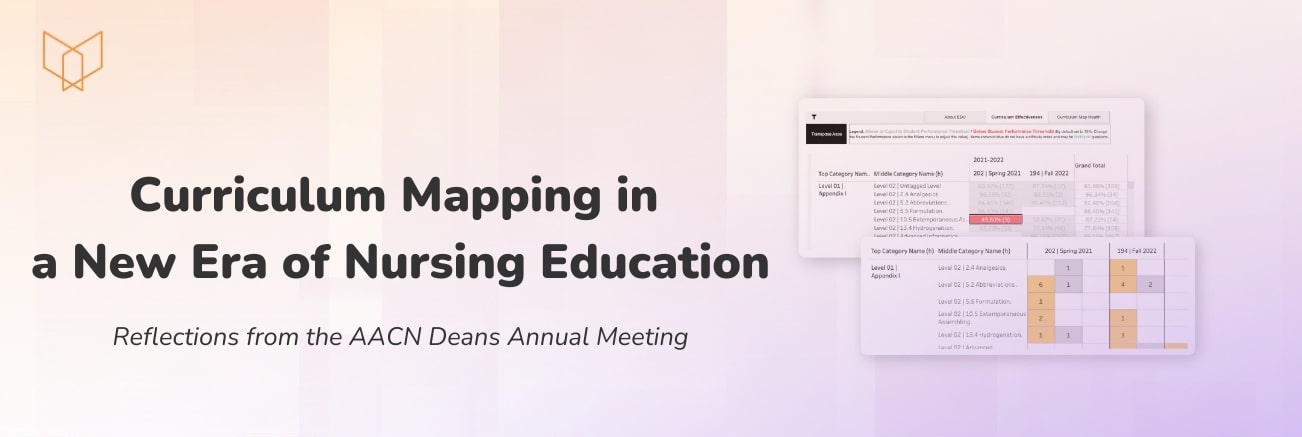
Insights from the AACN Deans Annual Meeting on Competency-Based Nursing Education
By Alejandra Zertuche, Founder & CEO of Enflux
At the recent AACN Deans Annual Meeting, nurse education leaders gathered to shape the future of nursing programs in the era of competency-based nursing education. The discussions were vibrant, the insights deep—and the shared challenges were clear.
Among them, one concern echoed across nearly every conversation: faculty overload.
I spoke with deans, associate deans, and curriculum leaders about their current curriculum cycles. Every institution seemed to be navigating a unique stage of transformation toward nursing competency-based education. Some were refining decades-old curricula, others were building programs from the ground up. Yet all agreed on one thing: the process demands time faculty simply don’t have.
When aligning curricula with the 2021 AACN Essentials—a cornerstone of AACN competency-based education—the stakes are high. And without strategic support, the burden can feel overwhelming.
Key themes from the conference agenda
The AACN conference agenda addressed some of the most pressing topics in academic nursing:
- Driving innovation through competency-based learning in nursing education
- Incorporating real-time data for quality improvement
- Aligning student outcomes with the new Essentials
- Preparing future-ready nurse leaders through holistic, outcomes-driven instruction
- Managing faculty workload and avoiding burnout in the era of digital transformation
Every session reinforced a growing truth: the transition to competency-based nursing education is no longer optional. It’s essential for accreditation, student success, and workforce readiness.
Faculty alignment starts with terminology clarity
One of the most common and often overlooked challenges in implementing competency-based nursing education is the confusion around foundational terms—competencies, outcomes, and objectives. These terms are frequently used interchangeably, and that creates real obstacles for programs working to align with AACN competency-based education frameworks.
In my conversations with faculty and curriculum leaders across institutions, I’ve seen how this confusion can significantly slow down progress toward effective nursing competency-based education. Competencies represent the broader, program-level expectations—what students should be able to do upon graduation. Outcomes are course-specific, and objectives are even more granular, tied to individual lessons or activities. When the distinctions between these are unclear, it becomes nearly impossible to create or align them effectively within a competency-based learning in nursing education model.
On top of that, ensuring consistency in how faculty interpret, apply, and track these elements remains a major hurdle. Even when program-level competencies are clearly defined, alignment efforts often fall apart if faculty aren’t mapping their courses or submitting the data necessary to maintain visibility. This lack of cohesion can derail even the most well-intentioned transition to competency-based nursing education, and makes achieving full alignment with AACN competency-based education feel out of reach.
A faculty-centered curriculum mapping approach
At Enflux, we’re addressing the challenge of curriculum alignment with a unique, faculty-centered process. By combining the power of AI with the expertise of seasoned subject matter experts, we guide educators through the curriculum mapping process in a way that’s both effective and energizing.
If you’d like to learn more, join us for our upcoming webinar featuring two renowned thought leaders in competency-based education:
- Dr. Barbara Aranda-Naranjo – A distinguished public health nurse, former Provost at the University of the Incarnate Word (UIW), and a global leader in academic innovation and experiential learning.
- Dr. Eula Pines – Professor of Nursing Emerita and a sought-after consultant in curriculum alignment and nursing competency-based education. Her expertise spans innovative teaching strategies, global health, and student wellness.
Customer success spotlight. Rocky Mountain University
We recently worked with Dr. Janet Noles and her team to accelerate their curriculum mapping efforts. Here’s what she had to say:
“Enflux made what seemed like an impossible task feel effortless. After just sharing the folder of all of our course syllabi, we had a fully mapped, accreditation-ready curriculum and a dashboard that shows all of our NP programs. This saved our faculty months of work and positioned us ahead of schedule for our CCNE review.”
— Dr. Janet Noles, Rocky Mountain University
This story is just one example of how we’re helping institutions thrive during the shift to competency-based learning in nursing education.
Get started with curriculum mapping today
Our Curriculum Mapping and Competency Alignment brochure outlines each step of the proven process—from collecting syllabi and identifying gaps, to integrating performance data and achieving accreditation.
Whether you’re just beginning to explore AACN competency-based education, or you’re actively seeking a partner to support your curriculum overhaul, we’re ready to guide you.
The shift toward competency-based learning in nursing education offers exciting opportunities to build stronger, more adaptive nursing programs. But the path doesn’t have to be burdensome.
By putting faculty first and using the right tools, we can meet accreditation standards, improve student outcomes, and renew energy for what matters most: educating the next generation of nurses.
If your team is ready to embrace streamlined nursing competency-based education, we’re ready to help.

Ready to simplify your approach to competency-based nursing education?
Book a free assessment call with Enflux to discuss your curriculum challenges and explore a streamlined path to alignment.

